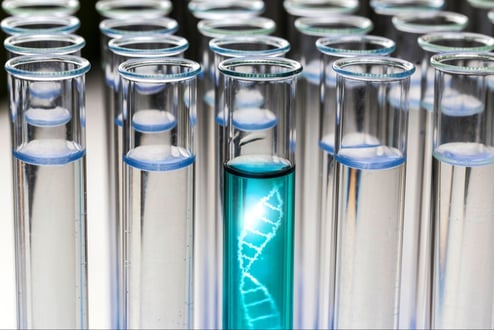Breast Cancer: Biomarker Testing
Testing for People with Breast Cancer
This section covers the following topics:
testing for treatment selection
tests look at samples of blood, tumor or other tissue for changes or abnormalities caused by cancer. These tests can give doctors clues about the cancer, including:
- how fast the cancer is growing
- which treatments are most likely to work
- whether or not the cancer is responding to treatment or growing
- whether or not the cancer has come back after remission
tests may be used to select treatments, and help patients avoid side effects from treatments that will not work for them. tests used to select a specific treatment are sometimes called "companion diagnostic tests." These tests may be done on tumor tissue or (in many cases) on blood. See our Testing section for more information.
After breast cancer tissue is removed by surgery or biopsy, all breast cancers are tested for three common biomarkers: receptors, progesteron receptors and a protein known as .
Hormone receptors: (ER) and progesterone (PR)
Testing is done to look for two separate hormone receptors, receptors (ER) and progesterone receptors (PR).
- Cancers that test positive for and progesterone receptors are known as . They may also be called . These cancers are often treated with hormone therapies.
- Cancers that test negative for and progesterone receptors are known as or HR-negative. These cancers are not usually treated with hormone therapy.
HER2 testing
is a protein that is found on all breast cancer cells. Tests measure the amount of protein in the tumor and provide a score from 0 to 3+.
- Cancers with a score of 3+ are considered . These cancers are often treated with drugs called "anti-HER2 agents."
- Cancers with a score of 1+ or 2+ are considered HER2-low. This is a relatively new label for breast cancer. In the past, these cancers would have been called or borderline. Advanced HER2-low breast cancers may be treated with the anti-HER2 agent Enhertu (T-DXd).
- Cancers with a score of 0 are called . These cancers are not treated with anti-HER2 agents.
Possible scores
HER2 Test Score |
HER2 Status |
Score is 0 |
HER2-negative |
Score is 1+ or 2+ |
HER2-low |
Score is 3+ |
HER2-positive |
Possible HER2 test results and meaning |
|
()
Breast cancers that are negative for the biomarkers ER, PR and are known as triple-negative breast cancers. These cancers do not usually respond to hormonal therapies or anti-HER2 targeted therapies. For this reason, is often treated with chemotherapy. New approaches to treating include and targeted therapies. Additional testing can help people learn if they qualify for other treatments.
Other biomarkers used for breast cancer treatment selection
Additional testing may be done to study the genes and proteins within the cancer to help doctors choose the best treatment. Some treatments will work best for people whose cancer cells have specific changes. These treatments are sometimes called targeted therapies. The for a specific is sometimes called a . Some tests look for only one at a time, while others may test for all many biomarkers at the same time. Panel tests look for multiple markers, including FDA-approved treatments as well as those that have not yet been proven effective in breast cancer. Examples of multiple tumor tests for breast cancer include:
- FoundationOne
- MSK-IMPACT
- Tempus xT
Examples of biomarkers used to guide breast cancer treatment include:
- ESR1 mutation testing in advanced breast cancer for treatment with the drug Oserdu (olacestrant).
- PIK3CA mutation testing in ER-positive, advanced breast cancer for treatment with the drug PIQRAY (alpelisib).
- , PIK3 or AKT1 mutation testing in , advanced breast cancer for treatment with the Truqap (capivasertib).
- PD-L1: Testing for the protein can help find people with advanced () who are most likely to respond to the drug Keytruda (pembrolizumab).
- Additional tumor testing may help people learn if they are eligible for certain clinical trials.
tests for prognosis in breast cancer
These tests are used for people with ER/PR-positive cancers to predict:
- if the cancer is likely to come back
- the benefit of adding chemotherapy to the treatment plan
- how long hormonal therapy should be used
Some examples of the most commonly used prognostic tests for breast cancer are listed below:
- Oncotype Dx
- Breast Cancer Index
- MammaPrint
- Prosigna
Genetic tests for inherited mutations for treatment selection
Genetic testing for an may be used to guide treatment selection for people diagnosed with breast cancer.
- People with advanced breast cancer who test positive for an inherited or mutation may benefit from treatments known as PARP inhibitors. Two PARP inhibitors—Lynparza and —are approved as for treating advanced breast cancer in people with a or mutation.
- Lynparza may be used to as therapy after treatment for people with an inherited or mutation who have breast cancer this is high risk for recurrence.
- People who test positive for other inherited gene mutations may qualify for clinical trials looking at targeted therapies to treat hereditary breast cancer.
Visit our section on genetic testing for people diagnosed with breast cancer.
Related Videos
The Role of HER2 Low in Breast Cancer
Biomarkers and Liquid Biopsies
Participate in Research

Talazoparib for People with Metastatic Breast Cancer Who Have Acquired (Somatic) BRCA Mutations
Clinicaltrials.gov identifier: NCT03990896

Testing a Vaccine for Treating or Preventing Triple-Negative Breast Cancer
Clinicaltrials.gov identifier: NCT04674306


